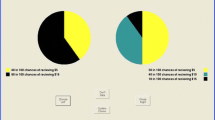Abstract
We show how bounds around preferences parameters can be estimated under various levels of assumptions concerning the beliefs of senders in the investment game. We contrast these bounds with point estimates of the preference parameters obtained using non-incentivized subjective belief data. Our point estimates suggest that expected responses and social preferences both play a significant role in determining investment in the game. Moreover, these point estimates fall within our most reasonable bounds. This suggests that credible inferences can be obtained using non-incentivized beliefs.
Similar content being viewed by others
References
Andersen, S., Harrison, G. W., Lau, M. I., & Rutström, E. E. (2006). Elicitation using multiple price list formats. Experimental Economics, 9, 383–405.
Andreoni, J., & Miller, J. (2002). Giving according to GARP: an experimental test of the consistency of preferences for altruism. Econometrica, 70(2), 737–753.
Bellemare, C., Bissonnette, L., & Kröger, S. (2007). Flexible approximation of subjective expectations using probability questions: an application to the investment game, IZA Discussion paper 3121.
Bellemare, C., Kröger, S., & van Soest, A. (2008). Measuring inequity aversion in a heterogeneous population using experimental decisions and subjective probabilities. Econometrica, 76, 815–839.
Bellemare, C., Sebald, A., & Strobel, M. (2010, forthcoming). Measuring the willingness to pay to avoid guilt: estimation using equilibrium and stated belief models. Journal of Applied Econometrics.
Berg, J., Dickhaut, J., & McCabe, K. (1995). Trust, reciprocity, and social history. Games and Economic Behavior, 10, 122–142.
Charness, G., & Rabin, M. (2002). Understanding social preferences with simple tests. Quarterly Journal of Economics, 117, 817–869.
Ciliberto, F., & Tamer, E. (2009). Market structure and multiple equilibria in airline markets. Econometrica, 77(6), 1791–1828.
Coller, M., & Williams, M. (1999). Elicitating individual discount rates. Experimental Economics, 2, 107–127.
Cox, J. C. (2004). How to identify trust and reciprocity. Games and Economic Behavior, 46, 260–281.
Eckel, C., & Wilson, R. K. (2004). Is trust a risky decision? Journal of Economic Behavior and Organization, 55, 447–465.
Ellingsen, T., Johannesson, M., Torsvik, G., & Tjøtta, S. (2010). Testing guilt aversion. Games and Economic Behavior, 68, 95–107.
Engelmann, D., & Strobel, M. (2004). Inequality aversion, efficiency and maximin preferences in simple distribution experiments. American Economic Review, 94(4), 857–869.
Fischbacher, U. (2007). z-Tree: Zurich toolbox for ready-made economic experiments. Experimental Economics, 10(2), 171–178.
Holt, C. A., & Laury, S. K. (2002). Risk aversion and incentive effects. American Economic Review, 92(5), 1644–1655.
Honoré, B., & Tamer, E. (2006). Bounds on parameters in dynamic discrete choice models. Econometrica, 74, 611–629.
Houser, D., Schunk, D., & Winter, J. (2010). Distinguishing trust from risk: an anatomy of the investment game. Journal of Economic Behavior and Organization, 74(1–2), 72–81.
Manski, C. (1989). Anatomy of the selection problem. Journal of Human Resources, 24(3), 343–360.
Manski, C. (1994). The selection problem (Vol. 1, pp. 143–170). Cambridge University Press, Cambridge.
Manski, C., & Tamer, E. (2002). Inference on regressions with interval data on a regressor or outcome. Econometrica, 70, 519–546.
Author information
Authors and Affiliations
Corresponding author
Additional information
Part of this paper first appeared in Bellemare et al. (2007). An OX code with files implementing all the procedures discussed in this paper can be downloaded at http://www.ecn.ulaval.ca/charles.bellemare/. We thank Jim Cox and the Economic Science Laboratory in Tucson, Arizona, for financial and technical support, Urs Fischbacher for his support in programming the experiment, Wafa Hakim for her research assistance in conducting the experiment, and two reviewers for comments.
Rights and permissions
About this article
Cite this article
Bellemare, C., Bissonnette, L. & Kröger, S. Bounding preference parameters under different assumptions about beliefs: a partial identification approach. Exp Econ 13, 334–345 (2010). https://doi.org/10.1007/s10683-010-9244-6
Received:
Accepted:
Published:
Issue Date:
DOI: https://doi.org/10.1007/s10683-010-9244-6



